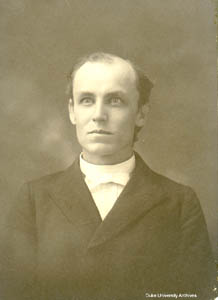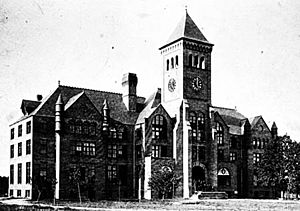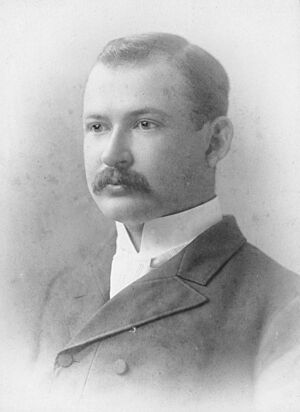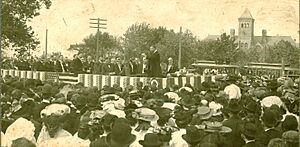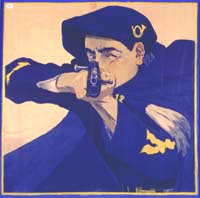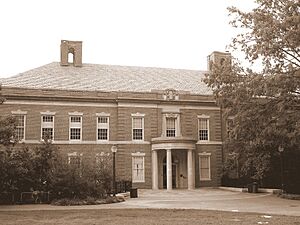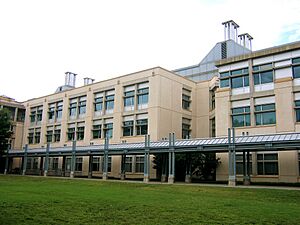History of Duke University facts for kids
The story of Duke University began in 1838 with a small private school called Brown's Schoolhouse. It was located in a town now known as Trinity.
Over the years, the school changed its name several times. In 1841, it became Union Institute Academy. Then, in 1851, it was called Normal College, and in 1859, it became Trinity College.
In 1892, the school moved to Durham, North Carolina. It grew a lot thanks to the kindness of Washington Duke and Julian S. Carr. These men were wealthy Methodists who made their money in the tobacco business.
Later, in 1924, Washington Duke's son, James B. Duke, created a large fund called The Duke Endowment. It was worth $40 million at the time. Some of this money was given to Trinity College. Because of this huge gift, the school was renamed Duke University. This was done to honor Washington Duke and his family.
Contents
Early Days: 1838–1886
The school started with a group of Methodists and Quakers. Their leader was Reverend Brantley York. In 1841, North Carolina officially recognized Union Institute Academy.
In 1851, the state allowed the academy to become Normal College. By 1853, it could even grant college degrees. To keep the school running, it offered free education to Methodist preachers. In return, the church provided financial help. In 1859, this partnership became official. The school changed its name to Trinity College and adopted the motto "Eruditio et Religio," which means "Knowledge and Religion."
This time period saw many important "firsts." In 1871, Chi Phi became the school's first student club. In 1878, Mary, Persis, and Theresa Giles were the first women to earn degrees. Back then, women could only attend as day students. In 1881, Yao-ju "Charlie" Soong from China enrolled. He was the school's first international student.
Moving to Durham: 1887–1900
In 1887, John Franklin Crowell became President of Trinity College. He was an economist who studied at Yale. Crowell wanted the college to focus more on research. He also convinced the leaders to move the school to a bigger city.
In 1892, Trinity College opened in Durham. This move happened mostly because of Washington Duke and Julian S. Carr. They were rich Methodists who made their money in the tobacco industry. Carr gave the land for what is now Duke's East Campus. Washington Duke gave $100,000 to help the school and build a dorm for women. He said women should be treated equally to men.
John C. Kilgo became president in 1894. He helped the Duke family become even more interested in Trinity. Washington Duke gave three more gifts of $100,000 each. In 1900, Trinity was the first college for white students in the South to invite Booker T. Washington to speak. Also in 1900, Joseph Maytubby became the first Native American student to graduate from Trinity.
The Bassett Affair: 1903
In 1903, a big disagreement happened at Trinity College. It became known as the "Bassett Affair." A popular professor named John Spencer Bassett wrote an article. In it, he talked about improving relations between different races. He also praised many African Americans. He even wrote that Booker T. Washington was "the greatest man, save General Lee, born in the South in a hundred years."
This article made many powerful leaders and the public very angry. Many people demanded that Professor Bassett be fired. They also encouraged parents to take their children out of the university. Because of this pressure, Bassett offered to resign if the school's leaders asked him to.
The Board of Trustees met to decide what to do. In the end, they voted not to accept his resignation. They said they believed in "academic freedom." This means professors should be free to think and speak the truth as they see it. They said they would not support anything that would limit this freedom in American colleges. In 1905, President Theodore Roosevelt praised Trinity for standing up for academic freedom.
The Blue Devils: 1922
The mascot for Duke's sports teams is the Blue Devil. It has an interesting story. After World War I, the school's leaders allowed football on campus again. People started thinking about a name for the teams.
Before, the teams were called the Trinity Eleven, the Blue and White, or the Methodists. The student newspaper, the Trinity Chronicle, wanted a new, clear mascot name. They asked for ideas. Some suggestions were Catamounts, Grizzlies, and Badgers.
The newspaper editor narrowed the list to names that used the school colors, dark blue and white. This list included Blue Titans, Blue Eagles, and Blue Devils. No name was a clear favorite. But "Blue Devils" caused some debate. The football season ended without an official name.
During the 1922–1923 school year, student leaders decided the newspaper staff should choose the name. The editors, William H. Lander and Mike Bradshaw, started calling the teams the Blue Devils. Even though it wasn't official, no one seemed to mind. The newspaper kept using the name, and eventually, "Blue Devils" became the official mascot.
Duke University is Born: 1924–1938
On December 11, 1924, James B. Duke created The Duke Endowment. This was a $40 million fund. The money from this fund was meant to help hospitals, orphanages, the Methodist Church, three colleges, and a new university built around Trinity College.
President William Preston Few insisted that the new university be named Duke University. James B. Duke agreed, as long as it honored his father and family.
The university grew very quickly. Duke's first campus (now East Campus) was rebuilt between 1925 and 1927. It featured buildings in the Georgian style. In 1926, the School of Religion and Graduate School opened.
By 1930, most of the Gothic Revival buildings on the new West Campus were finished. These buildings were for the men's Trinity College and the professional schools. The Women's College on East Campus opened in 1930. At the same time, the men's Trinity College, the Medical School, and the Hospital opened on West Campus.
The Law School, which started in 1904, was reorganized in 1930. The School of Nursing was founded in 1931. The beautiful Duke Chapel was finished in 1935. In 1938, the School of Forestry opened. This school later became the School of the Environment.
That same year, Duke's football team, called the "Iron Dukes," had an amazing season. They didn't allow any points against them during the regular season. They finally gave up a touchdown in the last minute of the 1939 Rose Bowl game against USC. Soon after, Duke University became a member of the Association of American Universities.
Growing Bigger: 1939–1992
Engineering had been taught at Duke since 1903. In 1939, it became its own school, the Pratt School of Engineering. In sports, Duke hosted the only Rose Bowl game ever played outside of California. This happened in Wallace Wade Stadium in 1942.
Until 1963, Duke University only accepted white students and faculty. That year, Duke began to desegregate. Five Black students, Mary Harris, Gene Kendall, Wilhelmina Reuben-Cooke, Cassandra Smith Rush, and Nathaniel White, enrolled. Today, Duke has a scholarship named in their honor.
Student activism grew in the 1960s. Martin Luther King Jr. spoke at the university on November 14, 1964. He talked about the progress of the civil rights movement. So many people came that his speech had to be played on loudspeakers outside.
Another important event for equality at Duke was The Silent Vigil at Duke University. It lasted from April 4 to April 12, 1968. Students, teachers, and staff held a peaceful protest. They wanted fair rights for campus workers. They also spoke out against racial unfairness in the local area.
Terry Sanford, a former governor of North Carolina, became president in 1969. This led to the opening of the Fuqua School of Business. The William R. Perkins library was also completed in 1969. This greatly increased the library's space and book collection. In 1971, the Institute of Policy Sciences and Public Affairs was founded.
In 1972, the separate Woman's College joined back with Trinity College. Trinity then became the liberal arts college for both men and women. The Mary Lou Williams Center for Black Culture opened in 1983.
Duke University Hospital was finished in 1980. It included units for medicine, surgery, children's health, and women's health. The Bryan University Center, a student union, was completed two years later.
Duke's first NCAA championship was won by the men's soccer team in 1986. This was followed by the men's basketball team winning back-to-back championships in 1991 and 1992. These wins were under the leadership of Hall of Fame Coach Mike Krzyzewski.
Recent History: 1993–Present
Duke University's growth and focus on academics have greatly improved its reputation. It is now known as a top research university. In 1993, Duke's math team won first place in the William Lowell Putnam Mathematical Competition. This is a very respected math competition for college students in the United States and Canada. Duke won again in 1996 and 2000. For many years, Duke's team has been one of the top three.
New buildings continued to be built on campus. The large Levine Science Research Center (LSRC) opened in 1994. It is a place for different types of research. Later that year, the Terry Sanford Institute of Public Policy moved to a new building. New dorms also opened on East Campus.
In 1995, Peter M. Nicholas gave $20 million to the School of the Environment. This school came from the School of Forestry and the Duke Marine Lab. Also, James B. Duke's daughter, Doris Duke, gave the university $10 million for research.
The next year, recreational facilities were updated. The Keith and Brenda Brodie Recreational Center opened on East Campus. The Wilson Recreation Center on West Campus also got a major update. In 1996, Robert Coleman (who earned his Ph.D. from Duke) won the Nobel Prize in Physics.
In 1998, Duke President Nan Keohane started a big fundraising effort called the Campaign for Duke. The goal was to raise $1.5 billion. Former President George H. W. Bush gave the graduation speech that year. Edmund T. Pratt, Jr. gave $35 million to the Pratt School of Engineering in 1999.
In the 2000s, campus growth continued. The Campaign for Duke ended in 2003, having raised over $2.36 billion. This was one of the largest fundraising campaigns in American higher education history.
In 2004, Duke spent over $490 million on research. This led to many important discoveries. The Duke Global Health Research Building began construction. It is one of four labs in the U.S. working to find new ways to fight infectious diseases. The Duke Smart House also began construction. This is a research center where students explore energy-efficient design.
More recent research includes a plan for an invisibility cloak using special "metamaterials." Duke researchers also helped map the final human chromosome. This was big news as the Human Genome Project was completed.
Sustainability Efforts
Duke University is working hard to be more sustainable. This means using resources wisely and protecting the environment. The school gets over 30% of its energy from wind and hydroelectric power. This makes it one of the top colleges buying renewable energy.
Duke tries to buy food from local farmers. Its dining halls use fair trade coffee and recycled napkins. They also recycle and compost waste.
Currently, 17 buildings on Duke's campus are LEED-certified. This means they meet high standards for being environmentally friendly. All new campus buildings will also need to meet this standard. Duke is also planning to redesign a large area of its central campus. This plan will include sustainable practices in every step of construction.
Because of its efforts, Duke University received a B+ grade from the Sustainable Endowments Institute's College Sustainability Report Card in 2008.
Important Dates
| Year | Name |
|---|---|
| 1838 | Brown School |
| 1841 | Union Institute |
| 1851 | Normal College |
| 1859 | Trinity College |
| 1924 | Duke University |
| Year | School/College |
|---|---|
| 1859 | Trinity College of Arts & Sciences |
| 1924 | School of Law |
| 1926 | Divinity School |
| 1926 | Graduate School |
| 1930 | School of Medicine |
| 1931 | School of Nursing |
| 1938 | School of the Environment |
| 1939 | School of Engineering |
| 1969 | School of Business |
| 1971 | School of Public Policy |
| 2000 | Duke-NUS Medical |
| Years | President |
|---|---|
| 1838–1842 | Brantley York |
| 1842–1863 | Braxton Craven |
| 1863–1865 | William Trigg Gannaway |
| 1866–1882 | Braxton Craven |
| 1883–1884 | Marquis Lafayette Wood |
| 1887–1894 | John Franklin Crowell |
| 1894–1910 | John Carlisle Kilgo |
| 1910–1940 | William Preston Few |
| 1941–1948 | Robert Lee Flowers |
| 1949–1960 | Arthur Hollis Edens |
| 1960–1963 | Julian Deryl Hart |
| 1963–1969 | Douglas Maitland Knight |
| 1969–1985 | Terry Sanford |
| 1985–1993 | H. Keith H. Brodie |
| 1993–2004 | Nannerl O. Keohane |
| 2004–2017 | Richard H. Brodhead |
| 2017–present | Vincent E. Price |
Timeline of Key Events
| Year | Event |
|---|---|
| 1838 | Brown’s Schoolhouse, a private school, is founded. |
| 1841 | Methodists and Quakers create Union Institute Academy. |
| 1851 | The state allows the academy to become Normal College. |
| 1859 | The Methodist Church provides financial support, and the name changes to Trinity College. |
| 1871 | The first student social club is founded on campus. |
| 1878 | The first women earn degrees. |
| 1881 | The first international student enrolls. |
| 1887 | J.F. Crowell becomes president. |
| 1892 | Trinity moves to Durham, thanks to Washington Duke and Julian S. Carr. |
| 1894 | J.F. Kilgo becomes president; Washington Duke donates $300,000. |
| 1900 | Trinity is the first white college in the South to invite Booker T. Washington to speak. |
| 1903 | The Bassett Affair, a debate about academic freedom, takes place. |
| 1922 | Newspaper editors create the name Blue Devils for athletic teams. |
| 1924 | James B. Duke establishes the $40 million Duke Endowment, leading to the name change to Duke University. |
| 1925 | The original campus is rebuilt with Georgian style buildings. |
| 1930 | Most of the new Gothic Revival-style West Campus buildings are finished. |
| 1938 | Duke's football team, the Iron Dukes, has a dominant regular season. |
| 1942 | Duke hosts the Rose Bowl in Wallace Wade Stadium. |
| 1964 | Dr. Martin Luther King Jr. speaks at the university about civil rights. |
| 1969 | Terry Sanford, a former governor, becomes president; Perkins library is completed. |
| 1971 | The Institute of Policy Sciences and Public Affairs is founded. |
| 1972 | The Women's College merges into Trinity College. |
| 1974 | The Mary Lou Williams Center for Black Culture opens. |
| 1980 | Duke Hospital opens. |
| 1986 | Men’s soccer wins Duke’s first NCAA championship. |
| 1991 | Men's basketball wins its first NCAA title. They would win again in 1992, 2001, and 2010. |
| 1993 | Keohane becomes the university's eighth president. |
| 1994 | Duke's team wins the Putnam Mathematical Competition. |
| 1994 | The Levine Science Research Center (LSRC) opens. |
| 1995 | East Campus becomes an all-freshmen campus. |
| 1996 | The Duke-Durham Neighborhood Partnership begins. |
| 1998 | The Campaign for Duke fundraising effort begins with a goal of $1.5 billion. |
| 1999 | Duke celebrates its 75th anniversary. |
| 2003 | Duke's Center for Human Genetics opens. |
| 2003 | The Campaign for Duke ends, raising over $2.36 billion. |
| 2004 | Brodhead becomes the ninth president. |
| 2004 | The Fitzpatrick Center (CIEMAS) opens. |
| 2005 | The Nasher Museum of Art opens. |
| 2005 | The Rolling Stones play in Wallace Wade Stadium. |
| 2010 | The men's lacrosse team wins its first national title. |
See also
- List of Duke University people


